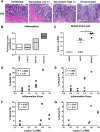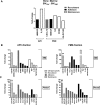Influence of Plasma Cell Niche Factors on the Recruitment and Maintenance of IRF4hi Plasma Cells and Plasmablasts in Vaccinated, Simian Immunodeficiency Virus-Infected Rhesus Macaques with Low and High Viremia
- PMID: 27928009
- PMCID: PMC5286871
- DOI: 10.1128/JVI.01727-16
Influence of Plasma Cell Niche Factors on the Recruitment and Maintenance of IRF4hi Plasma Cells and Plasmablasts in Vaccinated, Simian Immunodeficiency Virus-Infected Rhesus Macaques with Low and High Viremia
Abstract
In a recent study, we found that protection following simian immunodeficiency virus (SIV) exposure correlated with rectal plasma cell frequency in vaccinated female rhesus macaques. We sought to determine if the same macaques maintained high mucosal plasma cell frequencies postinfection and if this translated to reduced viremia. Although delayed SIV acquisition did not predict subsequent viral control, alterations existed in the distribution of plasma cells and plasmablasts between macaques that exhibited high or low viremia. Flow cytometric analysis of cells from rectal biopsy specimens, bone marrow, and mesenteric lymph nodes of vaccinated infected, unvaccinated infected, and uninfected macaques identified two main IRF4hi subsets of interest: CD138+ plasma cells, and CD138- plasmablasts. In rectal tissue, plasma cell frequency positively correlated with plasma viremia and unvaccinated macaques had increased plasma cells and plasmablasts compared to vaccinated animals. Likewise, plasmablast frequency in the mesenteric lymph node correlated with viremia. However, in bone marrow, plasmablast frequency negatively correlated with viremia. Accordingly, low-viremic macaques had a higher frequency of both bone marrow IRF4hi subsets than did animals with high viremia. Significant reciprocal relationships between rectal and bone marrow plasmablasts suggested that efficient trafficking to the bone marrow as opposed to the rectal mucosa was linked to viral control. mRNA expression analysis of proteins involved in establishment of plasma cell niches in sorted bone marrow and rectal cell populations further supported this model and revealed differential mRNA expression patterns in these tissues.
Importance: As key antibody producers, plasma cells and plasmablasts are critical components of vaccine-induced immunity to human immunodeficiency virus type 1 (HIV-1) in humans and SIV in the macaque model; however, few have attempted to examine the role of these cells in viral suppression postinfection. Our results suggest that plasmablast trafficking to and retention in the bone marrow play a previously unappreciated role in viral control and contrast the potential contribution of mucosal plasma cells to mediate protection at sites of infection with that of bone marrow plasmablasts and plasma cells to control viremia during chronic infection. Manipulation of niche factors influencing the distribution and maintenance of these critical antibody-secreting cells may serve as potential therapeutic targets to enhance antiviral responses postvaccination and postinfection.
Keywords: SIV rhesus macaque model; plasma cell; plasma cell niche factors; plasmablast.
Copyright © 2017 American Society for Microbiology.
Figures







Similar articles
-
Adjuvanting a Simian Immunodeficiency Virus Vaccine with Toll-Like Receptor Ligands Encapsulated in Nanoparticles Induces Persistent Antibody Responses and Enhanced Protection in TRIM5α Restrictive Macaques.J Virol. 2017 Jan 31;91(4):e01844-16. doi: 10.1128/JVI.01844-16. Print 2017 Feb 15. J Virol. 2017. PMID: 27928002 Free PMC article.
-
Early T Follicular Helper Cell Responses and Germinal Center Reactions Are Associated with Viremia Control in Immunized Rhesus Macaques.J Virol. 2019 Feb 5;93(4):e01687-18. doi: 10.1128/JVI.01687-18. Print 2019 Feb 15. J Virol. 2019. PMID: 30463978 Free PMC article.
-
A Prime/Boost Vaccine Regimen Alters the Rectal Microbiome and Impacts Immune Responses and Viremia Control Post-Simian Immunodeficiency Virus Infection in Male and Female Rhesus Macaques.J Virol. 2020 Nov 23;94(24):e01225-20. doi: 10.1128/JVI.01225-20. Print 2020 Nov 23. J Virol. 2020. PMID: 32967951 Free PMC article.
-
The role of immunity in protection from mucosal SIV infection in macaques.Oral Dis. 2002;8 Suppl 2:63-8. doi: 10.1034/j.1601-0825.2002.00014.x. Oral Dis. 2002. PMID: 12164663 Review.
-
Localization of Simian immunodeficiency virus-infected cells in the genital tract of male and female Rhesus macaques.J Reprod Immunol. 1998 Dec;41(1-2):331-9. doi: 10.1016/s0165-0378(98)00069-2. J Reprod Immunol. 1998. PMID: 10213321 Review.
Cited by
-
A Protein Epitope Targeted by the Antibody Response to Kawasaki Disease.J Infect Dis. 2020 Jun 16;222(1):158-168. doi: 10.1093/infdis/jiaa066. J Infect Dis. 2020. PMID: 32052021 Free PMC article.
-
B-Cell Responses in Chronic Chagas Disease: Waning of Trypanosoma cruzi-Specific Antibody-Secreting Cells Following Successful Etiological Treatment.J Infect Dis. 2023 May 29;227(11):1322-1332. doi: 10.1093/infdis/jiac495. J Infect Dis. 2023. PMID: 36571148 Free PMC article.
References
Publication types
MeSH terms
Substances
LinkOut - more resources
Full Text Sources
Other Literature Sources
Molecular Biology Databases
Research Materials

